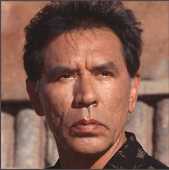 An expanded version of my Indian Comics Irregular essay Leaphorn and Chee Do Public TV:
An expanded version of my Indian Comics Irregular essay Leaphorn and Chee Do Public TV: An expanded version of my Indian Comics Irregular essay Leaphorn and Chee Do Public TV:
An expanded version of my Indian Comics Irregular essay Leaphorn and Chee Do Public TV:
PBS has broadcast an adaptation of the Tony Hillerman mystery Skinwalkers. It's the first American production in the formerly all-British "Mystery!" series. As the Milwaukee Journal Sentinel (11/22/02) explains:
Set largely on a Navajo reservation and populated almost entirely by Indian actors, "Skinwalkers"—adapted for the screen by Redford's son, James ("Ring of Fire"), and gracefully directed by Chris Eyre ("Smoke Signals")—looks in on a world both exotic and familiar.
The San Francisco Chronicle (11/24/02) continues:
"Skinwalkers" follows Lt. Joe Leaphorn (Wes Studi) and Officer Jim Chee (Adam Beach), who share a heritage but have divergent personalities. While Leaphorn is a by-the-book authority figure who doesn't look to his ancestors for answers, the younger Chee is a medicine man in training and well versed in Navajo history.
Both of them are trying to find a killer who is targeting medicine men. The killer, who leaves strange-looking tracks, is believed by some to be a "skinwalker," a man who can turn into an animal in midstride.
There have been recent movies that treat American Indians with respect ("Dances With Wolves," "Thunderheart," "Windtalkers"), but all of them are told through the eyes of a white protagonist (Kevin Costner, Val Kilmer, Nicolas Cage).
Other movies just throw a token, one-dimensional American Indian into the background. Eyre criticizes those films as "a slap in the face" because the characters are barely developed.
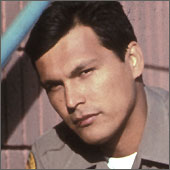
"It's kind of like charity, but it's not even charity because the story is propelled through that one-off character, yet we never really get to know what they are as people," he said.
Adds the Milwaukee Journal Sentinel:
Within this universe of brown faces, there are confident professionals and embittered losers, patient elders and trash-talking kids, those who have no use for the old ways and those who devotedly tend them like candle flames in a storm.
Leaphorn and Chee, like any modern crime solvers worthy of the name, are strong, independent personalities with a first-hand knowledge of life's dark side.
Rob's review
My reaction to Skinwalkers: The above is all true. The movie dealt honestly with the Native characters and culture, which is still rare in the entertainment media. Nevertheless, I was somewhat disappointed. A few problems:
It's a far, far cry distance-wise and geographically and certainly culture-wise from the Navajo Nation: far north/northeast of Superior in the high-altitude Colorado River plateau country of frequent cedars, pinons, yellow pines.
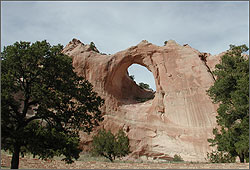
Although I didn't want to see the overused "mittens" of Monument Valley, the landscape seemed more like the generic Southwest than Dinetah, the Navajo homeland. I never had a good sense of where the characters were, which is unfortunate in a movie where place is important.
Further suggesting the problem, the PBS website for Skinwalkers uses a huge Saguaro cactus as a recurring motif. This cactus is a Southwest stereotype; it's basically not found on the Navajo rez.
The PBS site has a diagram of the links between characters. They've left off several characters, but it's still relatively complex. Each linkage between characters involves a subplot.
In the books, Leaphorn and Chee sometimes do this literally: visualize or actually draw the links between the people involved in a case. If you have to draw a diagram to understand the characters' relationships, I'd say you have too many characters. In a book you can stop and reflect, at least. Not so in a movie.
Movies of Hillerman's books aren't necessarily the best way to introduce people to Native culture. Because they're character-driven, because there isn't a lot of action or visual dynamics, these stories don't scream to be made into movies. To me, they're meant to be novels, not films.
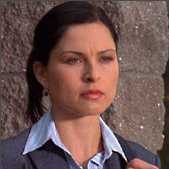
[W]hile Leaphorn was no longer truly a traditional, no longer offered a pinch of pollen to the rising sun, he still treasured the old ways of his people. (Hunting Badger, 1999)
In contrast, Chee is the inexperienced cop who's unsure of himself and his direction. Part of him wants to emulate Leaphorn, the pragmatic professional, and part wants to learn the traditional medicine ways. Chee is as awed by the old investigator as he is by the Navajo mysteries:
[Leaphorn's effect on Chee was] like a rookie reporting for basketball practice with Michael Jordan, or like a seminary student put on a committee with the pope. (Hunting Badger, 1999)
If there's a theme to the series, it's whether Chee can reconcile the two opposing pulls: the modern and the ancient. Not until the most recent books does Chee seem comfortable with himself and his legendary superior.
Cheaphorn and Lee?
The movie almost reverses Leaphorn and Chee. As the Associated Press (11/19/02) notes:
Joe Leaphorn is not his old self.
Instead of the wise, patient and culturally sensitive sleuth of literature, the Leaphorn of the first U.S.-set episode of the previously all-British "Mystery" series is redrawn as a grouchy urban cop who has lost touch with his Navajo roots and returns to the reservation with his ailing wife.
So Leaphorn is a blustery, procedure-bound outsider who knows little about Navajo culture. Chee is the composed, confidant insider who has already balanced detective and healing work. Chee shows Leaphorn how to conduct investigations on the rez, not the other way around. It's almost painful to see Leaphorn falling off a ladder or dismissing a clue that might be crucial.
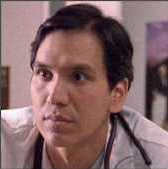
I'm not suggesting Hillerman's characters shouldn't be tampered with because they're as well conceived as Sherlock Holmes and Dr. Watson. But these characters aren't the Leaphorn and Chee I know. To stretch a metaphor, they're like skinwalkers—inhabiting the skins of Leaphorn and Chee, but acting like strangers.
And that's a shame. Now the relationship has been set for any future Hillerman movies on "Mystery!" Redford and company have botched the chemistry that made the Hillerman books a success.
Rob's rating for Skinwalkers: 7.5 of 10.
Skinwalkers an improvement?
This is the second movie Robert Redford has made of a Hillerman book. As the LA Times (11/17/02) explains:
Redford did get Hillerman's "A Dark Wind" made as a feature film in 1991. He was executive producer, it was directed by acclaimed documentary filmmaker Errol Morris and starred Lou Diamond Phillips and Fred Ward as the American Indian policemen. The film, says Redford, wasn't any good and wasn't released.
"That was a false start," Redford says. "It was miscast. It was ill-conceived and I didn't think it was the right beginning for the series. It wasn't distributed."
It may have been miscast and ill-conceived, but I consider Dark Wind the superior movie. It conveys the sweeping landscape, makes the plot manageable, and gets the main characters right. Check it out and see if you agree.
More on Skinwalkers
Hillerman happy with 'Skinwalkers'
Old Navajo ways and new meet in a mystery
Eyre turns his camera on American Indians
Photos from PBS's Hillerman movies
Coyote Waits
A Thief of Time
Related links
SKINWALKER defies taboos
The best Indian movies
TV shows featuring Indians
|
. . . |

|
All material © copyright its original owners, except where noted.
Original text and pictures © copyright 2007 by Robert Schmidt.
Copyrighted material is posted under the Fair Use provision of the Copyright Act,
which allows copying for nonprofit educational uses including criticism and commentary.
Comments sent to the publisher become the property of Blue Corn Comics
and may be used in other postings without permission.